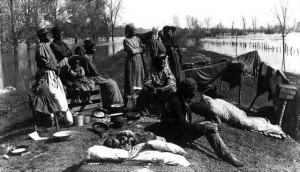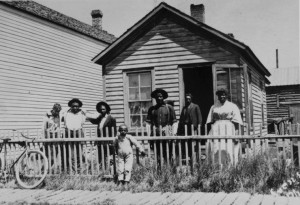I’m a visual learner, but I approach using images in my teaching with some trepidation. Even with useful guides to analyzing a picture, I worry about the contextual information that often does not accompany photos. Not every image comes with a complete photographers’ notes and an archive. But I recently found some great digital collections of images related to the Exodusters and black emigration of the late Reconstruction era that encouraged me to confront my fears and use images to inform a discussion of these events.
Finding contextualized images and primary texts helped me to take the leap into using images. In my African American political history course, I approached discussion of the Exodusters and the post-reconstruction emigration movement in the context of black responses to Reconstruction. The Schomburg-sponsored website “In Motion: The African American Experience” (www.inmotionaame.org), broadens the context of these episodes by placing them within a larger narrative of African migrations. Project director, Sylviane Diouf, stresses that there were 11 major migrations in the African American experience and only two of these were forced migrations—the transatlantic and domestic slave trades. All other movements were active projects of mobilization with clear motives and tangible goals. In addition to this critical framing of the theme of migration in the African American experience, this collection provides a clear narrative of the development of the migrations with links to primary and secondary sources embedded within the text. I did not use these texts in my class, though I can imagine assigning students to read the primary texts first and discussing what insights they are able to gather about the exodus and emigration movements and then allowing them to compare their insights to the website’s narratives. The images that accompany the narratives are also well chosen to support the narrative.
 With a clear narrative and images in place, I ventured to another site with more images and less context. The Library of Congress online exhibition, “The African American Mosaic: Western Migration” provides some great images to help stimulate discussion about the Exodus as a movement. Included in this collection of documents are images of Exodus leaders Benjamin Singleton and S. A. McClure in front of a ship loaded with people, a tableau called “Refugees on Levee” and a sketch of Exodusters from Harper’s Weekly. These images do not come with much contextual information, but the images lend themselves to thinking about the nature of a the movement, who participated and why. Those images along with the broadside in this collection help provide additional context to seeing this movement as an organized effort in which large numbers of people participated, in some form of communal grouping—as families or groups of extended kin.
With a clear narrative and images in place, I ventured to another site with more images and less context. The Library of Congress online exhibition, “The African American Mosaic: Western Migration” provides some great images to help stimulate discussion about the Exodus as a movement. Included in this collection of documents are images of Exodus leaders Benjamin Singleton and S. A. McClure in front of a ship loaded with people, a tableau called “Refugees on Levee” and a sketch of Exodusters from Harper’s Weekly. These images do not come with much contextual information, but the images lend themselves to thinking about the nature of a the movement, who participated and why. Those images along with the broadside in this collection help provide additional context to seeing this movement as an organized effort in which large numbers of people participated, in some form of communal grouping—as families or groups of extended kin.
Together these two sites provide a wealth of sources to inform discussions of post-Reconstruction political activities of blacks and an opportunity to directly engage students in history writing through analyzing images.
How do you use images to help students understand and interpret historical moments?




